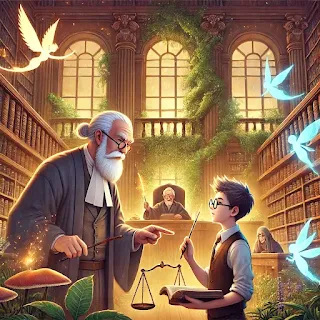The Ghibli Movement: A Unique Perspective on Its Evolution, Impact, and Legal Landscape.
Introduction.
The Ghibli Movement, rooted in the aesthetic and philosophical essence of Studio Ghibli, has transcended its origins to become a broader cultural and artistic phenomenon. Known for its enchanting storytelling, breathtaking animation, and profound themes, the movement has influenced not just animation but also literature, environmental activism, and even legal discussions surrounding intellectual property and creative rights.
While many focus on the nostalgic and artistic aspects of the Ghibli Movement, this article takes a distinctive approach—exploring its legal dimensions, its broader cultural implications, and how it shapes modern discourse on creativity and ownership. From Japan's stringent copyright laws to international intellectual property debates, we delve into the intricacies of protecting and preserving the spirit of Ghibli in a rapidly changing digital landscape.
The Essence of the Ghibli Movement.
Philosophical Foundations.
At its core, the Ghibli Movement is about the interplay of nature, folklore, and human experience. Studio Ghibli’s films emphasize themes of environmental stewardship (Princess Mononoke), personal resilience (Spirited Away), and the beauty of the mundane (My Neighbor Totoro). These values have permeated into global pop culture, inspiring not just filmmakers but also educators, activists, and urban planners who seek to design more sustainable and human-centric spaces.
Aesthetic and Cultural Influence.
The Ghibli Movement extends beyond films into literature, visual arts, and even fashion. The distinctive 'hand-drawn' animation style, soft color palettes, and dynamic character designs have led to a resurgence of interest in traditional animation techniques. Creators worldwide emulate this approach, integrating Ghibli-like narratives into web comics, independent animated features, and even video games.
The Legal Landscape: Intellectual Property and Beyond.
Japanese Copyright Laws and Studio Ghibli.
Japan enforces strict intellectual property (IP) protections under its Copyright Act, and Studio Ghibli has long maintained a firm stance on preserving the exclusivity of its creations. Unlike many Western studios that rely heavily on franchising and merchandising, Ghibli has limited its commercial exploitation, prioritizing artistic integrity. This has led to legal battles against unauthorized adaptations and copyright infringements.
International Intellectual Property Concerns.
Ghibli’s global influence brings forth complex IP challenges. While international treaties such as the Berne Convention provide some level of copyright protection, unauthorized distribution and fan-made content frequently test the boundaries of legality. The debate over ‘fair use’ versus ‘derivative works’ remains contentious, especially in an era where digital media makes unauthorized sharing easier than ever.
Trademark Issues and Studio Ghibli’s Global Expansion.
With its increasing global reach, Studio Ghibli faces another legal hurdle—trademark disputes. From unauthorized merchandise in Southeast Asia to counterfeit streaming services falsely claiming Ghibli content, the company has had to enforce trademark protections aggressively. The challenge lies in balancing accessibility with legal compliance, ensuring fans worldwide can engage with the content without undermining Ghibli’s creative rights.
The Ghibli Movement in the Age of AI and Digital Media.
AI-Generated Art and Ghibli’s Ethical Stance.
The rise of AI-generated artwork poses a significant challenge to traditional animation studios, including Studio Ghibli. While AI tools can replicate the studio’s unique artistic style, legal debates continue over whether such AI-generated content constitutes copyright infringement. The moral dilemma is equally crucial: should AI be allowed to mimic artistic legacies, or does this undermine human creativity?
Streaming Rights and Piracy.
As streaming services compete for exclusive rights to Ghibli films, legal battles have emerged over regional licensing. Some countries lack access to official streaming options, leading to widespread piracy. This raises questions about digital rights management (DRM) and whether current laws are equipped to handle the evolving landscape of media consumption.
Environmental Law and Ghibli’s Advocacy.
Environmental Activism in Ghibli Films.
Films like Nausicaä of the Valley of the Wind and Princess Mononoke highlight themes of ecological destruction, reflecting Studio Ghibli’s advocacy for environmental sustainability. This extends beyond fiction—Ghibli Museum’s architecture and its conservation-focused initiatives align with Japan’s environmental laws promoting sustainable urban development.
Legal Battles Over Conservation in Japan.
Ethical Implications and Future Directions.
The Ethics of Fan Creations.
A unique legal and ethical debate surrounds fan art, fan fiction, and unofficial adaptations of Ghibli works. While some studios embrace fan creativity, Ghibli has taken a conservative stance, discouraging unlicensed adaptations. This raises broader questions about how intellectual property laws should adapt to evolving fan-driven content without stifling creative expression.
Ghibli and the Future of Animation Law.
The Ghibli Movement is now at the crossroads of tradition and modernity. Legal experts and industry professionals debate whether current copyright laws sufficiently protect legacy animation while allowing for reasonable creative reinterpretation. Future reforms may involve hybrid copyright models, where studios grant limited licenses for derivative works under strict guidelines.
Conclusion: A Legacy to Protect and Evolve.
The Ghibli Movement is more than an artistic phenomenon—it is a testament to the enduring power of storytelling and cultural preservation. However, its growth also brings forth complex legal challenges that must be addressed at national and international levels. By balancing creative freedom with intellectual property protection, the Ghibli Movement can continue to inspire future generations while maintaining its unique identity in an ever-evolving digital age.
As we celebrate Ghibli’s legacy, we must also ensure that the movement remains legally safeguarded, ethically conscious, and artistically vibrant for decades to come. Only by striking this delicate balance can the world continue to cherish the magic that Studio Ghibli has gifted to humanity.



















0 Comments